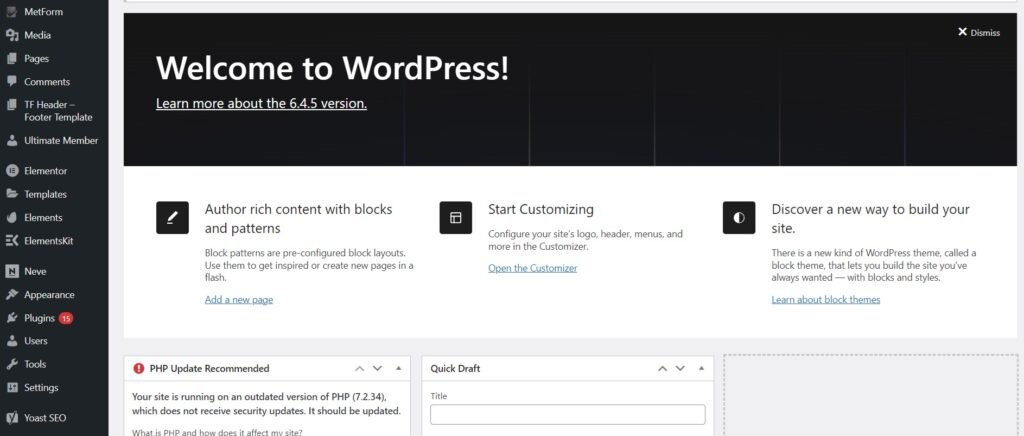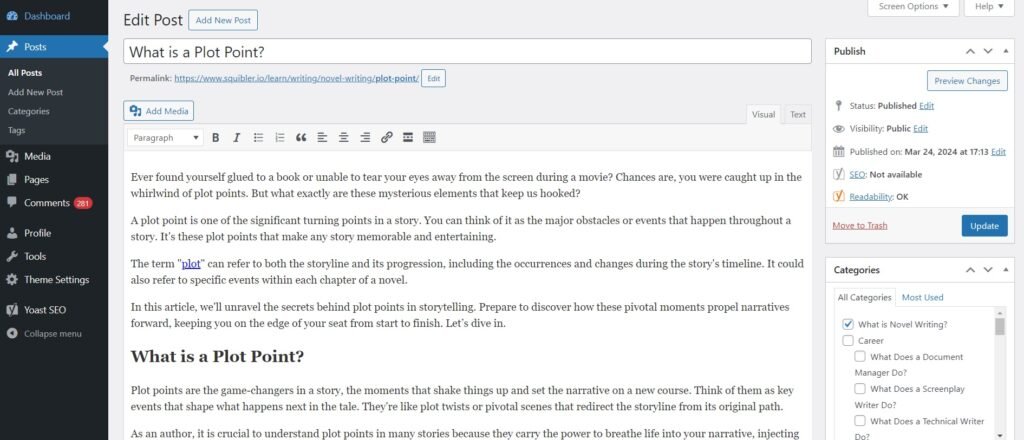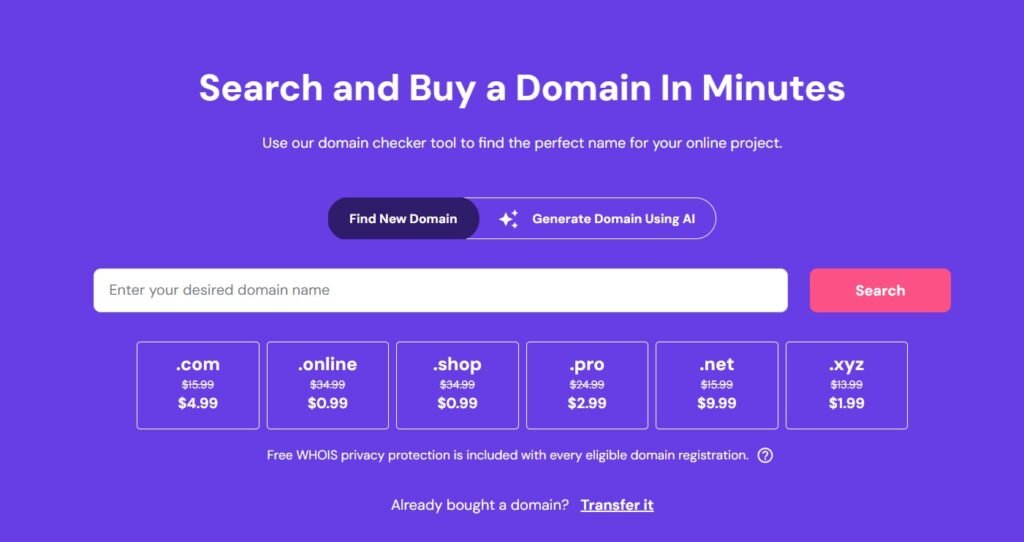10 Steps To Starting A Blog For Your Business In 2024

Angel Diaz
In this post, you’ll learn the creation process of a blog along with recommendations and valuable tips. 15-minute read.

Imagine having a powerful tool that not only showcases your expertise but also attracts potential customers to your business.
Starting a blog can be a game-changer. With the right SEO content strategy, you can share valuable insights, build trust with your audience, and significantly enhance your online presence.
In this guide, we will explore the steps to start a blog for your business in 2024, leveraging the latest strategies to ensure it generates leads and drives sales.
Whether you’re new to blogging or looking to refine your approach, these actionable steps will set you on the path to success.
How to Start a Blog That Generates Leads and Sales
Here are the steps to create your company blog successfully:
Step 1: Find a Domain Name for Your Website
Choosing the right domain name for your business blog is crucial because it becomes the online address where your audience will find you.
Here’s how to select the perfect domain name:
- Focus on Your Niche: Think about what your blog will be about. A domain name that reflects your business’s core theme or service can help attract the right audience.
- Check Availability: Ensure it’s unique and consider creative alternatives if taken by adding a word or two related to your business.
- Keep it Simple and Clear: Avoid complex or lengthy names. Make it easy to spell, pronounce, and remember.
- Align with Your Brand: It should match your brand identity and give readers a clear idea of your blog’s content.
Deciding on the right domain name sets the foundation for your blog’s success.
Step 2: Set Up your CMS
A reliable Content Management System (CMS) is essential for managing your business blog efficiently. WordPress remains the most popular choice due to its flexibility and user-friendly interface.

You can go for other options like Joomla, Magento, or Drupal to get started quickly with an easy setup process.
Install any necessary plugins you might need such as Yoast SEO plugin (free) or Jetpack by WordPress.com ($30/year). These plugins will automatically optimize all of your content for search engine ranking so that people can find you when they look for what you have to sell online.
Step 3: Do Market Research
To determine the best types of blog posts for your company, you need to conduct thorough market research. Start by asking yourself, “What content is my audience most interested in?” and “What type of content can I create to reach potential buyers?”
By understanding your customers’ personas and the problems they are trying to solve, you can create targeted blog posts that appeal directly to them.
Analyze your competitors’ content, use tools like Ahrefs and SEMrush to find popular topics and keywords, and explore social media platforms to gauge your audience’s interests.
Conducting market research ensures that your blog content is relevant, engaging, and effective in attracting and converting potential customers, turning your blog into a valuable lead generator.
Step 4: Create an Email List
Converting blog readers into customers often starts with building an email list. To do this, create compelling content that encourages people to subscribe for regular updates. This helps build a dedicated group of followers.
An email list is crucial for any business, especially when starting a blog. Initially, you’ll need to work harder to get subscribers since your content isn’t well-known yet. However, having an email list can greatly benefit you in the long run, providing a direct channel to engage with potential customers and drive conversions.
Step 5: Do Keyword Research
Dynamic keyword research is essential for developing a successful blog. Using the right keywords ensures your content reaches the people most likely to need it.

Start by typing a general keyword related to your topic into a tool like Google Keyword Planner or Ahrefs. Then, refine your search based on factors like region or time frame. For example, if you’re blogging about African American hair care in New York City, focus your keyword research on terms relevant to New York.
This targeted approach helps you understand what your audience is searching for, allowing you to create content that is both relevant and discoverable.
Regularly update your keyword list to stay aligned with evolving trends and search behaviors, ensuring your blog remains effective in attracting and engaging readers.
Step 6: Create a Content Strategy
Using the right keywords in the wrong type of content can lead to poor results. To be considered relevant by search engines like Google, you need to create content that answers users’ queries and provides value.
Start by developing a content strategy. Determine the type of information your target audience wants the most (i.e., informational vs. inspirational). Focus on keywords that are relevant to your topic and have an appropriate volume of monthly searches.
Next, decide on the format your audience will respond to best, whether it’s text articles, videos, infographics, or a mix. Consider the length and frequency of posts necessary to maintain relevance and engagement.
With these elements in place, you can begin crafting content that meets your audience’s needs and aligns with your SEO goals, ensuring your blog effectively attracts and retains readers.
Step 7: Start Creating Posts
At this stage, focus on creating high-value organic articles that align with your SEO goals. Start by thoroughly researching your topic to ensure accuracy and depth. Outline your post with a goal of 40-80 words per paragraph to maintain readability and engagement.
Incorporate images or infographics to enhance your blog’s message and provide visual interest for readers. These elements can help break up text and make your content more appealing.

Define the tone and perspective of your writing to set your blog apart from others. Whether it’s professional, conversational, or somewhere in between, consistency in style will help build your brand identity.
Revising and editing are crucial steps in the writing process. Go through several rounds of revisions to ensure your post is grammatically sound, logically organized, and polished before publishing.
Step 8: Do On-Page SEO
Optimizing your blog posts for search engines is essential. Start by adding relevant keywords to your post’s title and meta description in WordPress or your chosen blogging platform.
Enhance your SEO by using headers with targeted keywords, such as “What You Need to Know Before You Start Blogging,” and naturally incorporating these keywords throughout your content.
Develop a strong internal linking strategy to connect related posts within your blog, improving navigation and keeping readers engaged. While external links can boost traffic, internal links are vital for SEO and user experience.
Include a compelling call-to-action (CTA) at the end of each post, encouraging readers to sign up for email notifications or share your content on social media. This will help grow your email list and increase referral traffic, boosting your blog’s overall reach and effectiveness.
Step 9: Do Off-Page SEO
To enhance your content’s authority, focusing on off-page SEO is crucial. This strategy will help your blog rank higher in search engines, making it easier for new readers to find your content.
Begin by sharing your articles on platforms like Medium and LinkedIn, where you can reach a relevant audience. These sites offer opportunities to earn valuable backlinks, which boost your blog’s exposure and credibility.
Once you’ve posted on these platforms, use tools like MozBar or Ahrefs to track your content’s performance in search engines. This tracking will help you understand what type of content resonates with readers and what doesn’t, allowing you to refine your strategy for better results.
By leveraging off-page SEO, you can significantly improve your blog’s visibility and authority, attracting more readers and potential customers.
Step 10: Adjust your SEO strategy
Once your articles begin to appear on SERPs, it’s time to start monitoring your site’s metrics. Use tools like Google Search Console, Google Analytics, Ahrefs, or SEMrush to track performance. These tools provide insights into which keywords are driving traffic and how often they’re searched.
By analyzing this data, you can identify which posts are performing well and understand the reasons behind their success. Use these insights to refine your strategy and SEO efforts, ensuring continuous improvement and better results over time.
What are the Benefits of Creating a Blog for Your Business?
Starting a blog offers numerous advantages that can significantly impact your business growth and online presence. Here are some key benefits:
- Create an Online Community: Build engagement and interaction among readers.
- Showcase Expertise: Demonstrate your knowledge of specific topics.
- Attract New Customers: Provide detailed information to draw in potential customers.
- Improve Search Engine Rankings: Boost your website’s visibility on search engines.
- Drive Targeted Traffic: Attract visitors interested in your niche.
- Build Relationships: Foster one-on-one connections with customers, encouraging loyalty and return visits.
A blog is crucial for business growth, connecting with your audience, enhancing your online presence, and driving sales.


